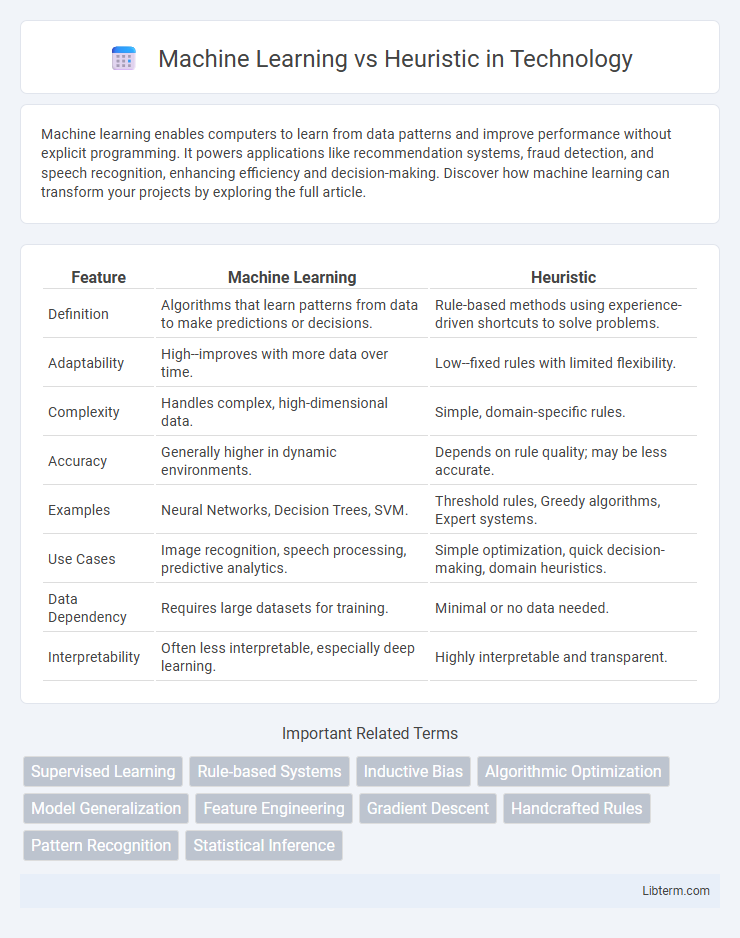Machine learning enables computers to learn from data patterns and improve performance without explicit programming. It powers applications like recommendation systems, fraud detection, and speech recognition, enhancing efficiency and decision-making. Discover how machine learning can transform your projects by exploring the full article.
Table of Comparison
| Feature | Machine Learning | Heuristic |
|---|---|---|
| Definition | Algorithms that learn patterns from data to make predictions or decisions. | Rule-based methods using experience-driven shortcuts to solve problems. |
| Adaptability | High--improves with more data over time. | Low--fixed rules with limited flexibility. |
| Complexity | Handles complex, high-dimensional data. | Simple, domain-specific rules. |
| Accuracy | Generally higher in dynamic environments. | Depends on rule quality; may be less accurate. |
| Examples | Neural Networks, Decision Trees, SVM. | Threshold rules, Greedy algorithms, Expert systems. |
| Use Cases | Image recognition, speech processing, predictive analytics. | Simple optimization, quick decision-making, domain heuristics. |
| Data Dependency | Requires large datasets for training. | Minimal or no data needed. |
| Interpretability | Often less interpretable, especially deep learning. | Highly interpretable and transparent. |
Introduction to Machine Learning and Heuristics
Machine learning involves algorithms that enable systems to learn patterns from data and make predictions or decisions without explicit programming, emphasizing adaptability and continuous improvement. In contrast, heuristics are rule-based approaches derived from experience or intuition, designed for efficient problem-solving with simplified decision-making processes. Understanding these distinctions highlights machine learning's reliance on data-driven models versus heuristic methods' dependence on predefined logical shortcuts.
Defining Machine Learning: Concepts and Types
Machine learning is an artificial intelligence approach that enables systems to learn from data patterns and improve performance without explicit programming, encompassing types such as supervised, unsupervised, and reinforcement learning. Supervised learning involves training algorithms on labeled data to predict outcomes, while unsupervised learning detects hidden patterns in unlabeled data. Reinforcement learning uses reward-based feedback to optimize decision-making processes, distinguishing machine learning's adaptive capabilities from the rule-based, predefined logic of heuristic methods.
What Are Heuristics? Principles and Examples
Heuristics are problem-solving techniques based on experience and rules of thumb that simplify decision-making processes by reducing computational complexity. Rooted in principles such as trial-and-error, pattern recognition, and educated guesses, heuristics provide quick, albeit approximate, solutions where exhaustive algorithms are impractical. Examples include the A* search algorithm in pathfinding and the use of satisficing strategies in optimization, contrasting with machine learning which relies on data-driven models and statistical inference for prediction and classification tasks.
Key Differences Between Machine Learning and Heuristic Approaches
Machine learning utilizes data-driven algorithms to automatically improve performance and adapt to new information, while heuristic approaches rely on predefined rules and expert knowledge for problem-solving. Machine learning models optimize accuracy through training on large datasets, whereas heuristics provide faster, less resource-intensive solutions with limited adaptability. The key difference lies in machine learning's scalability and ability to generalize versus heuristic methods' simplicity and domain-specific efficiency.
Advantages of Machine Learning Methods
Machine learning methods offer superior adaptability by automatically improving performance through data-driven insights, unlike heuristic approaches which rely on predefined rules. These methods excel in handling complex, high-dimensional data and uncovering hidden patterns without explicit programming. Machine learning also enhances scalability and robustness, making it ideal for dynamic environments requiring continuous learning and optimization.
Strengths and Limitations of Heuristic Techniques
Heuristic techniques offer simplicity and speed by utilizing rule-based problem-solving approaches that are especially effective for well-defined, smaller-scale problems where exhaustive search is impractical. These methods are limited by their dependency on expert knowledge, making them less adaptable and prone to suboptimal performance in complex or dynamic environments. Unlike machine learning, heuristics do not improve from data over time, restricting their ability to generalize beyond predefined rules.
Use Cases: When to Choose Machine Learning
Machine learning excels in use cases involving large datasets with complex patterns and dynamic environments, such as fraud detection, recommendation systems, and natural language processing. It adapts to new data through continuous learning, making it ideal for applications where rules may change or unknown variables emerge. In contrast, heuristic methods suit well-defined problems with fixed, simple rules but lack the flexibility required for evolving or complex scenarios.
Use Cases: When Heuristics Excel
Heuristics excel in use cases requiring quick decision-making with limited data, such as rule-based systems, diagnostic procedures, and real-time troubleshooting. These approaches perform well in environments where explicit programming of domain-specific knowledge or experience-based rules can efficiently guide actions without extensive training data. Heuristics are ideal for optimization problems, expert systems, and scenarios where interpretability and speed outweigh the need for model complexity.
Hybrid Approaches: Combining Machine Learning and Heuristics
Hybrid approaches combining machine learning and heuristics leverage the adaptive capabilities of ML algorithms with the domain-specific efficiency of heuristic rules to improve decision-making accuracy and computational speed. These methods use machine learning models to identify patterns and optimize parameters while heuristics provide constraints and guidance based on expert knowledge, leading to more robust and interpretable solutions. Implementing hybrid systems enhances performance in complex tasks like optimization, anomaly detection, and real-time prediction by balancing data-driven insights with rule-based reasoning.
Future Trends and Perspectives in Problem-Solving Techniques
Machine learning leverages data-driven algorithms to adapt and improve problem-solving over time, while heuristic methods rely on rule-based, experience-driven shortcuts to find solutions quickly. Future trends emphasize hybrid approaches that combine machine learning's predictive accuracy with heuristic efficiency to tackle complex, dynamic problems across industries. Advances in AI and increased computational power will drive the integration of these techniques, enhancing decision-making in areas like autonomous systems, cybersecurity, and personalized medicine.
Machine Learning Infographic

 libterm.com
libterm.com